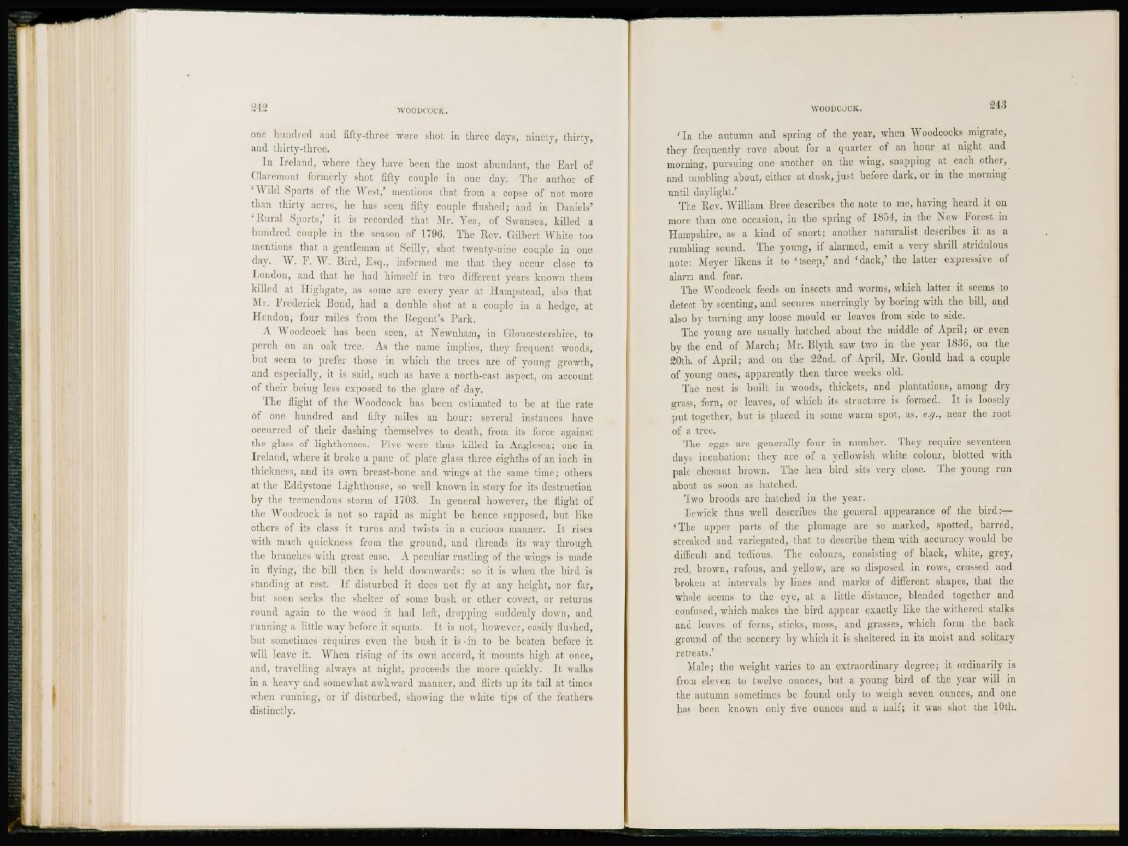
24& WOODCOCK.
one hundred and fifty-three were shot in three days, ninety, thirty,
and thirty-three.
In Ireland, where they have been the most abundant, the Earl of
Claremonl formerly shot fifty couple in one day. The author of
' W i l d Sports of the West,' mentions that from a copse of not more
than thirty acres, he has seen fifty couple flushed; and in Daniels*
* Rural Sports,' it is recorded that Mr. Yea, of Swansea, killed a
hundred couple in the season of 1796. The Rev. Gilbert White too
mentions that a gentleman at Scilly, shot twenty-nine couple in one
day. W. P. W. Bird, Esq., informed me that they occur close to
London, and that he had himself in two different years known them
killed at Highgato, as some are every year at Kampstead, also that
Mr. Frederick Bond, had a double shot at, a couple in a hedge, at
i I en don, four miles from the Regent's Bark.
A Woodcock has been seen, at Newnham, in Gloucestershire, to
perch on an oak tree. As the name implies, they frequent woods,
hul seem to prefer those in which the trees are of y/otmg growth,
and especially, il is said, such as have a north-east aspect, on account
of their being less exposed to the glare of day.
The flight of the Woodcock has been estimated to be at the rate
of one hundred and fifty miles an hour: several instances have
occurred of their dashing themselves to death, from its force against
the glass of lighthouses. Five were thus killed in Anglesca; one in
Ireland, where it broke a pane of plate glass three eighths of an inch in
thickness, and its own breast-bone and wings at the same time; others
at the Eddystone Lighthouse, so weU known in story for its destruction
by the tremendous storm of 1703. In general however, the flight of
the Woodcock is not so rapid as might be hence supposed, but like
others of its class ir turns and twists in a curious manner. It rises
With much quickness from (he ground, and threads its way through
the branches with great ease. A peculiar rustling of the wings is made
in flying, the bill then is held downwards: so it is when the bird is
standing at rest. If disturbed it does not fly at any height, nor far,
hut soon seeks the shelter of some bush or other covert, or returns
round again to the wood it had left, dropping suddenly down, and
running a little way before it squats. It is not, however, casdy flushed,
but sometimes requires even the bush it is-in to be beaten before it
will leave it. When rising of its own accord, it mounts high at. once,
and. travelling always at night, proceeds the more quickly. If walks
in a heavy and somewhat awkward manner, and flirts up its tail at times
when running, or if disturbed, showing the white tips of the feathers
distinctly.
WOODCOCK. 243
' I n the autumn and spring of the year, when Woodcocks migrate,
they frequently- rove about for a quarter of an hour at night and
morning, pursuing one another on the wing, snapping at each other,
and tumbling about, either at dusk, j u s t before dark, or in the morning
until daylight.*
The Rev. William Bree describes the note to me, having heard it on
more than one occasion, in the spring of 1854, in the New Forest in
Hampshire, as a kind of snort; another naturalist describes it as a
rumbling sound. The young, if alarmed, emit a very shrill stridulous
note: Meyer likens it to ' t s e e p , ' and 'dack,' the latter expressive of
alarm and fear.
The Woodcock feeds on insects and worms, which latter it seems to
detect by scenting, and secures unerringly by boring with the bill, and
also by turning any loose mould or leaves from side to side.
The young are usually hatched about the middle of April; or even
by the end of March; Mr. Blyth saw two in the year 1836, on the
20th. of April; and on the 22nd. of April, Mr. Gould had a couple
of young ones, apparently then three weeks old.
The nest is built in woods, thickets, and plantations, among dry
grass, fern, or leaves, of which its structure is formed. It is loosely
put together, but is placed in some warm spot, as. e.g., near the root
of a tree.
The eggs are generally four in number. They require seventeen
days incubation: they are of a yellowish white colour, blotted with
pale chesnut brown. The hen bird sits very close. The young run
about as soon as hatched.
Two broods arc hatched in the year.
Bewick thus well describes the general appearance of the bird:—
' T h e upper parts of the plumage are so marked, spotted, barred,
streaked and variegated, that to describe them with accuracy would be
difficult and tedious. The colours, consisting of black, white, grey,
red, brown, rufous, and yellow, arc so disposed in rows, crossed and
broken at intervals by lines and marks of different shapes, that the
whole seems to the eye, at a little distance, blended together and
confused, which makes the bird appear exactly like the withered stalks
and leaves of ferns, sticks, moss, and grasses, which form the back
ground of the scenery by which it is sheltered in its moist and solitary
retreats.'
Male; the weight varies to an extraordinary degree; it ordinarily is
from eleven to twelve ounces, but a young bird of the year will in
the autumn sometimes be found oidy to weigh seven ounces, and one
has been known only five ounces and a naif; it was shot the 10th.